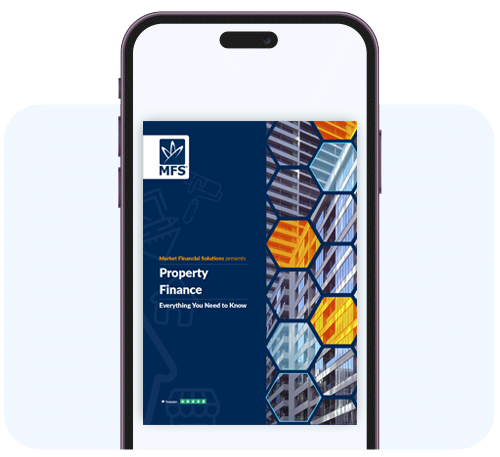The Complete
Everything You Need to Know
- Property finance explained in a comprehensive 26-page guide
- Foundations & types of property finance
- Useful tools to calculate how much you can borrow
- Ins & outs of the borrowing process
- Market insights & real-life examples
Get your free Property Finance Guide below.

Property finance:
Your investment guide
In this guide, we will explore the property finance world in its entirety. We will look at the available options, how they differ, when they’d be utilised in specific contexts, and more.
There are various types of finance for property investors and homeowners available. And it can be overwhelming to know where to start. New entrants to the market may not even realise that short-term property finance is available alongside more mainstream, long term mortgage options.
We will help clarify some of these issues. By the end of this guide, readers should have a better understanding of where their circumstances will fit in within the property finance picture, and be able to move forward with confidence.

The property market
At its most basic level, the property market concerns the supply and demand (the buying and selling) of buildings and land. This includes residential housing, commercial properties, and more.
Property markets can be divided into specific, region based sub-sectors which are affected by a range of factors. For example, supply and demand can be swayed by price variations, location, the economic climate, transport links, and more.

Foundations of property finance
For investors, attaining the right property investment finance will be a crucial part of their investment journey. The majority will need specific funds behind them. This capital needs to cover a property’s price, various fees, insurance costs, and potential taxes.
Choosing the right finance will be dependent on the underlying borrower’s circumstances. A home buyer looking for a house to raise a family in will likely require a standard residential mortgage. A business owner who wants to expand their office space may seek out a business loan. A portfolio landlord facing a chain break could utilise short-term property finance to keep an investment from falling through.
Given the variants involved, various advisors, brokers, and experts can help guide borrowers on what’s right for them.
However, there are still a few key terms and/or formulas all borrowers should concern themselves with.
Key terms
LTV: Lenders will assess their cases through the loan-to-value (LTV) ratio, which assesses the overall risk involved. An LTV ratio shows how much a person is borrowing against the value of their property as a percentage. Generally, the higher the percentage, the higher the risk, which could potentially translate to higher interest rates.
Net present value: Used to assess the profitability of an investment. It is the difference between the present value of cash inflows and outflows over a period of time.
Rental yield: Used by landlords to determine the annual sum they could reasonably expect to receive in rent as a proportion of a property’s value. Expressed as a percentage and the higher the better.
Capital growth: An increase in the value (property price) of an investment over time. Typically the concern of investors seeking long term profit over income.
Exit strategy: A crucial element in short-term property finance. It is the plan put in place to repay a bespoke loan by the time its term comes to an end. Common examples include selling an asset to cover what’s owed, or moving onto long term finance.

Financial analysis in property investment
Analysing the financial viability of any property investment will likely depend on the end goals. An opportunity for a student let may look different to that of a commercial property.
Nevertheless, the evaluation process could start similarly for most investment types. Firstly, investors will likely want to identify their goals and what part of the market they want to target.
Secondly, they can then conduct market research on their target market. For example, if they’re targeting students, they could look into UK towns with large student populations.
Once a potentially suitable property has been found, investors can do their due diligence on the asset itself. This includes research on the condition of the property, as well as financial analysis on its feasibility. Here is where net operating income (NOI), price per square foot etc can complete a financial picture.
Landlords may want to start with a cash flow analysis. This involves calculating how much net cash a property will generate, taking into account all sources of income, and all expenses. For property investors seeking a singular, transactional return, the return on investment (ROI) calculation may prove more useful. This involves comparing the amount invested in a property, including the initial purchase price, plus any further costs, to its eventual value or sold price[1].
An investor’s time horizon will likely also play a crucial, often underestimated role in their investment. Generally, property prices[2] and rents[3] tend to rise over time. Where investors can plan for the long term, the chances of experiencing a loss may be minimised.
Analysing the financial merits of any investment can be difficult however. And this is before costs, taxes, and risks come into play. Therefore, it’s advisable to seek out expert guidance before undertaking any investment.
Investment strategies
The analysis or calculations needed for a property will largely depend on the investment strategy. Investors have many strategies available to them. And often, these strategies can intermix and be adapted.
A common strategy for many property investments is to “buy and hold”. This involves purchasing a property, and holding it over a long time period in the hope that its value rises.
Those looking for a quicker return may opt for a “fix and flip” strategy. This, in some ways, works opposite to the buy and hold strategy. Here, typically, investors purchase a property at a lower price (usually as a result of being run down or dilapidated). They improve it and then sell it on at an increased value.
Income seeking investors will likely adjust their strategies according to the tenants they’re targeting. Those wanting to follow the momentum of a burgeoning industry could invest in commercial premises for said industry.
Buy-to-let investors trying to generate seasonal boosts to their income may invest in a holiday let or student accommodation. What’s more, these kinds of strategies could be combined. A student let could be rented out during the academic year. Then in the summer months the property could then be advertised to tourists.
Outside of directly investing in property, alternative vehicles may also be available. Real estate investment trusts (REITs) for example are companies that people can invest in that own and/or manage income producing assets across the property industry. This can provide exposure to the property market, without actually owning a building itself.
Similar investment vehicles include property unit trusts, crowdfunding ventures, property open-ended investment companies (OEICs), and more. Though, no matter what investment strategy is followed, it’s important to make sure they match up with the underlying investor’s circumstances.

Market analysis and trends
A local property market can be affected by trends in the wider industry and vice versa. Therefore, it’s important to conduct robust, broad market analysis ahead of time.
Investors, when they find a potential property to invest in, should assess its credentials. This could involve comparing its price to similar properties in the area, and looking at the condition of the building. But, it’s also worth looking at whether demand for housing is rising in the local area, what kind of properties are proving popular with tenants, and if any part of the region sees a boost during the summer months etc.
There are several tools and resources that can help with this. On top of news stories in the trade press, there are public data points available[4]. There are also various reports from professional bodies[5] which can shed light on a targeted market.
In addition, it’s possible to get ahead of, and potentially benefit from trends in the property market. Cornwall, for instance, often sees a huge uptick in tourism in the summer from holiday makers and second homeowners. But, the region goes quiet in the winter[6].
It may also be worth looking at the demographics of a location and how it may change down the line. If a town has an ageing population, it may be worth exploring retirement housing before demand (and prices) jump.
On the flip side, if a city is proving popular with younger generations who could be on the verge of starting families, investing in large family homes could pay dividends down the line.
Planning ahead as much as possible before an investment should improve the chances of success. At a minimum, it should help investors avoid unexpected, costly surprises.

High street vs. specialist lender
Given all the variables involved, it’s important for investors to work with the right lenders and products for their circumstances. There are thousands of providers out there, all with their own unique ways doing things. But, property finance can generally come from two different sources: mainstream/high street lenders, or specialist/bespoke lenders.
Each play their role in the property market. And whether their products suit people or not will depend on many variables. But, generally, high street banks will likely deal with more straightforward cases and investment plans.
Those with complicated circumstances, or who have imperfect backgrounds, may be better suited with specialist lenders. Specialist lenders can support property investors who may not get very far with mainstream providers. Finance brokers can help with the choice of a lending route.
Types of property finance
There are many types of property finance available to borrowers and investors. Mortgages tend to be the most common option for many. A mortgage is a type of loan or form of security. It is usually issued by a bank or building society, which allows borrowers to buy a property. They’re used to purchase residential properties. But it is also possible to get commercial and buy-to-let mortgages.
Get your free guide to buy-to-let mortages.
Bespoke property loans are also available, which may be referred to as specialist bridging loans, or short-term finance. These products can be used as finance on property purchases, but can also be used for a wide range of other purposes. This includes refinancing, funding a business venture, locking in an auction bid, and more.
The government also provides a number of schemes and funding options that can be put towards property purchases. A Lifetime ISA[7], for example, can include a 25% bonus from the government for people saving towards their first home. Other schemes such as Help to Buy [8]and the updated Mortgage Guarantee Scheme[9] are also available.
The right property finance and investment option for a borrower will depend on their circumstances. Also, within the broad financing options, there are also several forms of sub-categories and niche products. Property investors will need to consider their options carefully, and/or consult with a broker before moving ahead.

Property finance for different property types
Investors can filter their searches based on the type of property or asset they’re investing in. Different property markets will require different kinds of property finance.
Residential Properties
Residential properties are likely the main focus of many borrowers and investors. These properties can include detached homes, apartments, bungalows, and more. Those looking to purchase a home to live in will likely require a basic mortgage. For property investors, a residential bridging loan may prove more useful.
Specialist lenders can provide numerous niche products to help with residential investments. For example, a refurbishment loan could be put towards upgrading a flat for awaiting tenants.
Second charge loans can help investors raise additional funding for new investments. Meanwhile, bad credit bridging loans are specifically designed for borrowers who may have missed payments or CCJs in their backgrounds.
Commercial Properties
For business property investments, such as offices or retail stores, commercial bridging loans or mortgages could prove useful. This type of finance can be but towards commercial purchases, but it too can be sub-categorised into more specific options.
There are business bridging loans available that can help companies expand, and/or invest in property. Short-term property finance more generally can also be used by limited companies, LLPs, offshore companies, and more.
This kind of finance can be used for multiple purposes. These can include investing in property, advancing a business plan, or purchasing new machinery to increase output. Where commercial issues throw up unexpected costs, this funding can cover the bills, and allow borrowers to focus on the long term.
Industrial Properties
Industrial properties fall into the commercial category. But they tend to be more substantial in size and scope. When people refer to industrial properties, they’re often focusing on manufacturing hubs, warehouses, data centres, and more. These types of assets can be much larger than, say, a corner shop or small restaurant.
Commercial property finance can be used here. But, considering how substantial the investments may be, other options may also prove useful. Complex loans, for example, could be used for those who are investing in unique assets or via unusual circumstances. This may be particularly relevant for investors who may be investing via complex company structures, or who are facing tight corporate deadlines.
Foreign nationals can utilise overseas finance on property to expand in the UK market. The specialist lending market could prove especially useful for overseas borrowers who may struggle to attain funding from high street banks.
Mixed-Use Properties
Mixed-use properties are buildings that have multiple use classes within the same space. A common example is a building that has a pub on the ground floor, with a flat above it.
The property finance required for these types of investments may be more nuanced. Semi-commercial bridging loans are designed to accommodate these investments. They can be used for a range of investments and projects including acquisitions, renovations, releasing capital from an asset for a sperate venture, or re-financing an existing facility for more flexibility.
Larger loans, which can stretch into several millions of pounds, could also be utilised. Semi-commercial buildings can be especially large. A high rise building may include residential flats, a gym, and retail stores all within the same structure. If an investor plans to purchase all of these as part of the same deal, they’ll likely require a particularly large amount of capital to progress.

Property finance options based on circumstances
Finance on property can also be dependent on the type of investment being made. Developers, for instance, can receive different types of property finance based on where they are in the process. A developer at the beginning of their plans will likely need ground up development finance.
This is a form of finance that can be used to assist with the building or development of a residential or commercial property (or properties). Often, this property investment finance can be split into two parts. Initial funding will be used to purchase a development site. Following this, capital will be deployed to fund the building costs, and get the project moving.
Developers coming towards the end of their projects may instead utilise development exit finance. Developer exit bridging loans are short-term funds designed to cover original development finance. They are often used to secure extra time to finish works, figure out long term finance solutions, or find the right buyers for a development.
Those making a purchase at auction are another example of investors who may require a very specific form of property finance. Auctions can present property investors with opportunities to purchase properties cheaply. It could then be sold on for a profit after a refurbishment, for example.
But, purchases made via an auction often need to be wrapped up within 28 days of the gavel falling. This leaves investors with little time to spare, let alone capacity to react to unexpected surprises down the line. As such, seeking out auction finance, which has been designed from the get-go to keep up with the fast pace of the auction world, could pay dividends.
Secured vs. unsecured loans
Loans tend to fall into one of two categories: unsecured or secured loans. Unsecured loans are those issued by a bank or a lender that aren’t secured against an asset. Repayments are made until the loan, and any interest owed is covered.
Should a payment be missed, penalty fees will be issued. If an investor is not be able to repay the loan at all, the lender may take them to court[10]. Common examples of unsecured loans include student loans, personal loans, and credit card debt.
Property investors are more likely to take out secured loans. These are secured against the property or land the loan will be used to purchase. They can also (depending on the lender involved) be secured against other forms of security such as commercial equipment, high value vehicles, or even artwork.
Generally, secured loans may be better suited for property investors specifically[11]. They can allow for larger loans, accommodate those with less-than-perfect financial backgrounds, and provide flexibility.

Property finance calculators
No matter what kind of investment a borrower is engaging with – whether it’s a bridging purchase, a BTL investment, or an auction bid – our free-to-use property finance calculator will be able to help. Our interactive tool will allow investors to calculate how much they may be able to borrow, what will need to be repaid, and whether we’ll be able to provide them with the bridging finance they need.
The calculator requires a few details on the investment. The estimated results will be updated as they’re entered. This includes the loan amount, potential monthly repayments, and applicable LTV.
Basic details on the property used as security will be required, such as its value and any outstanding mortgage amount. Regardless of the investment type, we require a security property value of around £140,000. We also have a maximum LTV of 75%.
Also, we’ll need to know the size of the loan required, and an expected term. Investors especially need to be mindful of the latter. An auction purchase may require a shorter term, for example. A development exit plan could be stretched over several months. Across our bridging products, our terms range between three and 24 months.
Users will also be able to select a preferred repayment plan. They’ll be able to choose from 3 options: rolled up, part serviced, or pay interest monthly. Also, investors will be able to vary the interest rates and arrangement fee figures to see how they’ll affect the loan.
At the bottom of the calculator is a “contact us” button. This will put them touch with our teams which is the crucial next step. All the results displayed in the calculator will be estimations, and to get exact figures investors will need to reach out to us directly.
Regulation
Broadly, regulated property loans are used for a home that the borrower will be living in. Residential mortgages, along with lifetime mortgages (equity release), are regulated by the FCA. The FCA, through regulation, aims to ensure lending practices in the residential mortgage market are fair and transparent. The regulations are there to protect borrowers from financial challenges and exploitation.
Where mortgage lenders go bankrupt, borrowers are protected under the Financial Services Compensation Scheme (FSCS[12]). Although, there are limitations on what is covered, and what can be recovered as compensation[13].
Specialist property finance products, such as bridging loans or BTL mortgages, are not regulated by the FCA. This means that while they’re less protected than residential mortgages, they can offer more flexibility for borrowers. Specialist lenders might not be regulated by the FCA, however, they can voluntarily adhere to certain standards set by industry associations and bodies like the NACFB[14], FIBA[15], ASTL[16], and IMLA[17]. Market Financial Solutions is member of all four associations.

Affordability and stress testing
Lenders, specifically mortgage lenders, assess a borrower’s affordability through many metrics. While criteria will vary between lenders, most will likely consider the size of the borrower’s deposit, their employment status, their income, and other debts they may have.
At a minimum, lenders will require borrowers to have a deposit of 5%[18]. Typically, they only issue mortgages that are 4-4.5x the borrower’s salary. Some lenders may be willing to go up to six times. Others may only offer three times a person’s yearly income[19].
Lenders, as part of the assessment process, will also look into a borrower’s credit history and conduct stress tests. These tests assess whether borrowers would be able to afford their repayments should interest rates rise.
For landlords specifically this concerns the interest coverage ratio (ICR). This assesses how well a landlord will be able to repay a BTL mortgage. The ICR is a percentage of the expected rental income when compared to stressed interest costs. As a minimum, lenders must test at 125% ICR[20]. This means that the rental earnings must be at least 125% of the landlord’s mortgage costs.
At Market Financial Solutions, across our bridging products, we assess our deals based on the property/investments value, as opposed to the borrower’s income levels. This allows us to be more flexible with the borrowers we service. What’s more, for our BTL mortgages, we have a target ICR of up to130%.

Property finance eligibility
Property finance is available for a wide range of borrowers and investors. While each lender will have its own preferences and limitations, broadly, both individuals and corporate entities can approach lenders for support via several setups.
Individuals can apply for mortgages, specialist loans, business funding, and more. These individuals can be standard workers, entrepreneurs, self-employed traders, or even foreign nationals.
It’s also possible to receive property finance via a corporate setup. Limited companies can receive funding to expand their property portfolios, or otherwise enhance their business. Funding could also be applied for by LLPs, SPVs, offshore companies, trusts, and more.
Each individual lender will have its own preferences for who (or what) it works with. Some may only be willing to work with single borrowers, while others may specialise solely in corporate loans.
Property finance eligibility can also be categorised by investor type. Property developers, expanding landlords, commercial entities, and more can all turn to specialist lenders for funding.
It’s important that, regardless of background or circumstance, all borrowers do their due diligence on the lenders they want to work with. Each lender will have its own unique eligibility criteria which may not work for all borrowers.
At Market Financial Solutions, we’re happy to hear from borrowers aged between 21 and 85, who are investing in either England or Wales. We also consider applicants from any country, other than those that are sanctioned.
Also, no matter how complicated a borrower’s circumstance may be, we will always do what we can to provide property finance. We can accommodate those facing tight deadlines, dealing with chain breaks, who have missed mortgage payments in their history etc.

Underwriting process
Just as different lenders have different eligibility criteria, they’ll likely also have varying underwriting processes. Lenders will assess a borrower’s eligibility and following this, an underwriting team will verify that all the details are correct an accounted for.
Typically, this involves verifying the borrower(s) identity and reviewing their financial history. They also gather relevant data and paperwork on the borrower’s investments. This is the due diligence that’s required for all borrowers to ensure finance is put to use in the most secure way.
How long this all takes will depend on the borrower’s circumstances, as well as several external factors. But, at Market Financial Solutions, we can deliver funding in as little as 3 days following an enquiry where everything lines up.
While robust, our underwriting efforts follow a relatively straightforward process. Once we’ve received an enquiry, we will conduct an initial assessment. Should the application fit in with our criteria, we will issue a decision in principle (DIP). If the terms are accepted, we will get the valuation sorted. We then instruct the solicitors to act so we can move towards completion.
Finally, as the final documents are checked and approved, funds will be transferred to the borrower for draw down. They can then put the funding towards their investment, whether that be a property purchase, refurbishment, or auction bid.

Repayment process
For mortgages, there are typically three common repayment options available. Capital and repayment mortgages[21] are the ones most borrowers will likely be familiar with. Here, the monthly repayments cover the capital borrowed, and interest accrued over a specific term.
Then there are interest-only mortgages. With these products, the borrower only covers the interest with the repayments. They’ll need to cover the capital at the end of the term.
The third option will involve a combination of a capital and repayment plan, and interest-only repayments.
There are more niche repayment options available however, especially outside the mainstream mortgage market. For instance, there are investment backed repayment plans[22], where borrowers agree to invest the cash saved in a policy such as an equity plan.
At Market Financial Solutions, we offer fully retained repayment plans, serviced monthly options, or a combination of the two for our bridging products. Meanwhile, our BTL mortgages can accommodate rolled interest, deferred months, top slicing, and more.

Exit strategy
An exit strategy is a plan for repaying a bridging loan or other type of property finance. It is a crucial element of the property investment process. In fact, some lenders won’t issue property finance without a clearly defined exit strategy in place.
Specialist lenders tend to support more riskier borrowers who often have complicated backgrounds. As such, the loans available may be more costly than the typical mortgage, reflecting the risk involved.
This means that bespoke property finance should only be utilised for relatively short periods – often just a few months. To avoid long term costs piling up, borrowers should prioritise finalising their exit strategy as soon as possible.
The two most common exit strategies, arguably, are selling an asset (usually a property) to cover the loan, or refinancing with long-term lenders. However, other options may be available, so long as they’re practical and realistic. For instance, a borrower may plan to cover their property finance with an expected inheritance, or the returns from a recent business deal.
What’s accepted as an exit strategy will also vary from lender to lender. At Market Financial Solutions, we place few limitations on exit strategies. We just need to see evidence for our borrower’s plans, and verify the details wherever possible.
It’s also possible to exit one of our bridging loans internally. A borrower, for example, could move from a residential bridging loan onto one of our BTL mortgages. Every borrower we work with will have an assigned underwriter from day one who will work with them on the feasibility of their exit strategy.
Property finance market stats
- UK mortgage approvals in early 2024 reached their highest level since October 2022 as borrowing costs fell, according to data by the Bank of England[23].
- Bridging completions in the fourth quarter of 2023 rose by 18.4% on the third quarter of the year to reach £1.69 billion. Loan books also continued to rise in Q4 2023, increasing by 4.2% to reach new high of £7.6 billion[24].
- Total secured commercial lending is predicted to rise by 32% from an estimated £90bn in 2023, to £118bn in 2028[25].
- 2023 saw a record-breaking 50,004 limited companies being set up across the UK for buy to let investment, exceeding the previous year’s record by 3%[26].
- Based on historic trends, Zero Deposit estimates that the average rent across England could climb to £1,150 per month by 2030, an increase of 16%[27].
Insights from industry experts
“The research we’ve undertaken shows that, while some property professionals are scaling back or exiting the market, the majority are committed to developing their portfolios and many are even taking advantage of the temporary reduction in property prices to expand. When looked at in the round, the scale of the opportunity is significant.” – Rob Thomas, economist and principal researcher at IMLA[28]
“In summary, 2023 was a blip. A bum year. They happen. Market Financial Solutions is in a good position – we haven’t stopped lending, we have a large number of funding lines behind us, we’ve grown our workforce, we’ve expanded our products, and we’ve invested in tech. We are ready for 2024, so you can be too.” – Mike Cook, chief mortgage officer at Market Financial Solutions
“As a London developer, I look around this city in awe of the architectural legacy we are lucky enough to have. We have structures dating back to the Romans, then a bounty of masterpieces from the Georgians and Victorians. We have some of the best architectural practices on the globe, and some of the best, most adventurously conceived skyscrapers in the world.” – Thomas Balashev, chief executive of Monta Capital[29]

Case Study 1: An investor was looking to expand their portfolio
Finance on property can, evidently, come in many forms. This is especially true in the specialist lending market. Everything from residential purchases through to complex overseas structures needs to be accommodated.
Fortunately, we’re able to provide funding for a broad range of property investors and strategies here at Market Financial Solutions. Even where challenging circumstances emerge. One recent borrower turned to us for support with just such a case.
They required a BTL mortgage to expand their portfolio[30]. But they presented several issues from the outset that needed to be addressed. Not only did they have missed payments in their credit history, but their personal situation could have made it difficult to attain long term finance.
We needed to find a solution for this, given that their proposed exit strategy was to move onto long-term finance. The underwriter started by looking at the missed payment issue and it was noted that it had recently been resolved. What’s more, we saw the borrower kept up to date with all their other obligations.
We then turned to their unique personal situation. While potentially limiting their options, this could still be accommodated by a number of lenders further down the line. Also, the borrower had a backup exit strategy option available should it be needed. With these potential issues addressed, we found a way forward and could issue funds.

Case Study 2: Refurbishment works meant specialist finance was needed
Investment plans, alongside a borrower’s background, can also throw up challenges. A landlord investing in an HMO property required funding to refurbish the space, make it compliant with the rules, and attract premium tenants[31].
Time was of the essence. So we gathered paperwork to confirm that plans were in place to work on the property. We also evidenced that the borrower had the financial means to get the refurbishment started as soon as possible.
Furthermore, our underwriter confirmed the property was in a strong location, meaning it would be desirable for potential tenants or buyers. With everything accounted for, we were happy to deliver the required refurbishment finance.

Case Study 3: Clearing and consolidating existing financial arrangements
Sometimes, rather than helping with a new investment, our property finance can also be used to tidy up existing obligations. A property investor needed our funding to clear and consolidate existing charges secured against multiple properties.
The short-term property finance would allow the borrower to clear what was owed, and provide optionality when it came to refinancing for the exit strategy. But, a number of issues emerged during the background checks which would need to be covered by our funding. While the securities offered plenty of potential, we took the step of adding extra protection to the deal.
Our underwriter worked with the borrower’s solicitors to make sure that all their financial commitments would be repaid prior to, or upon the completion of our loan. As such, they’d be able to look at refinance for the exit strategy with no hindrances. With a fresh start on the horizon, we issued the capital required[32].
Why work with Market Financial Solutions
Market Financial Solutions has never stopped lending since its founding in 2006 and since then, we’ve branched out to cover the breadth and depth of the property market. On top of standard purchases, our property finance can be used for conversions, auction bids, development exit plans, second charges, and so much more.
The property investment landscape has only become more complicated in recent years. But we aim to match that complication with robust, bespoke loans that truly adapt to the needs of the market.
We have no way of knowing what could be on the way in the market, nor how property finance and investment strategies will need to evolve. But, what we do know for sure is that regardless of what surprises loom, we will adjust for the sake of our brokers and their clients.
Conclusion
The modern economy requires finance on property to be flexible, accommodating, and foolproof. There is no one right answer in the property market, and bespoke lenders recognise that better than most. In fact, their sole purpose is to find solutions where others can’t.
Where things go wrong in the property market, or the mainstream lending scene, short-term property finance will be there to provide respite and a way forward. Even for those who have less-than-perfect backgrounds.
Investors in need of property finance that’s tailored for them will find what they need in the bridging and specialist BTL industry. So long as their investment holds potential, and their exit strategy is clear and reasonable, we will be there to take their call.
[1] https://www.investopedia.com/articles/basics/11/calculate-roi-real-estate-investments.asp
[2] https://landregistry.data.gov.uk/app/ukhpi/browse?from=1950-01-01&location=http%3A%2F%2Flandregistry.data.gov.uk%2Fid%2Fregion%2Funited-kingdom&to=2024-02-01&lang=en
[3] https://www.ons.gov.uk/economy/inflationandpriceindices/bulletins/indexofprivatehousingrentalprices/january2024
[4] https://www.ons.gov.uk/peoplepopulationandcommunity/housing/bulletins/housingenglandandwales/census2021
[5] https://www.rics.org/news-insights/research-and-insights
[6] https://www.express.co.uk/news/uk/1844222/cornwall-pretty-uk-seaside-town-polruan
[7] https://www.gov.uk/lifetime-isa
[8] https://hoa.org.uk/advice/guides-for-homeowners/i-am-buying/government-schemes-help-buy-home/
[9] https://www.gov.uk/government/publications/the-mortgage-guarantee-scheme
[10] https://www.moneyhelper.org.uk/en/everyday-money/credit/secured-and-unsecured-borrowing-explained
[11] https://www.moneysupermarket.com/loans/unsecured-loans-vs-secured-loans/
[12] https://www.fscs.org.uk/what-we-cover/mortgages/
[13] https://www.which.co.uk/money/savings-and-isas/savings-accounts/fscs-are-my-savings-safe-aW00D9u2dt8m#does-the-fscs-cover-mortgages-insurance-and-investments
[14] https://nacfb.org/
[15] https://www.fiba.org.uk/
[16] https://theastl.org/
[17] http://www.imla.org.uk/
[18] https://www.moneysupermarket.com/mortgages/how-much-can-i-borrow/#:~:text=Lenders%20will%20want%20to%20see,P60%2C%20showing%20your%20annual%20income
[19] https://www.onlinemortgageadvisor.co.uk/mortgage-affordability/mortgage-affordability-checks/
[20] https://www.which.co.uk/money/mortgages-and-property/buy-to-let/buy-to-let-mortgages-explained-afOT30q4eEK9
[21] https://www.moneyhelper.org.uk/en/homes/buying-a-home/mortgage-repayment-options
[22] https://www.firstmortgage.co.uk/mortgage-repayment-methods/
[23] https://www.ft.com/content/045f773a-420d-45ac-8684-872748e1c1fd
[24] https://theastl.org/index.php/2024/02/22/bridging-loan-books-hit-another-new-high/
[25] https://www.financialreporter.co.uk/uk-commercial-property-lending-to-rise-32-to-118bn-by-2028.html
[26] https://www.commercialtrust.co.uk/news/limited-companies-set-up-at-record-high/
[27] How will the UK residential rental market develop up … (propertyinvestortoday.co.uk)
[28] https://www.financialreporter.co.uk/uk-commercial-property-lending-to-rise-32-to-118bn-by-2028.html
[29] https://www.propertyreporter.co.uk/which-design-features-will-buyers-pay-the-most-for.html
[30] https://www.mfsuk.com/case-study/credit-history-issues-btl-investment/
[31] https://www.mfsuk.com/case-study/hmo-needs-refurbishment/
[32] https://www.mfsuk.com/case-study/covering-existing-charges/
Disclaimer
Market Financial Solutions are a bridging loan and buy-to-let mortgage provider and are not legal, financial, investment or tax advisers. This document is for informational purposes only and does not, and should not be considered, to constitute legal, financial, investment or tax advice or be relied upon by any person to make a legal, financial, investment or tax decision. Therefore, Investors are encouraged to seek appropriate professional advice. The information in this content is correct at time of writing.
